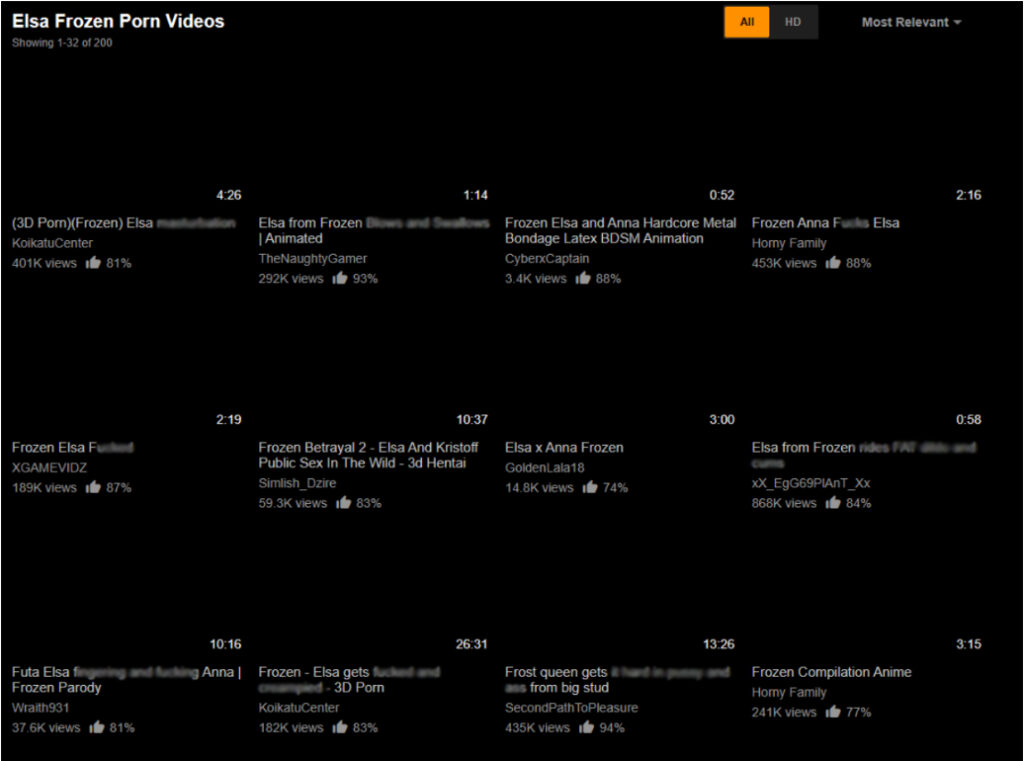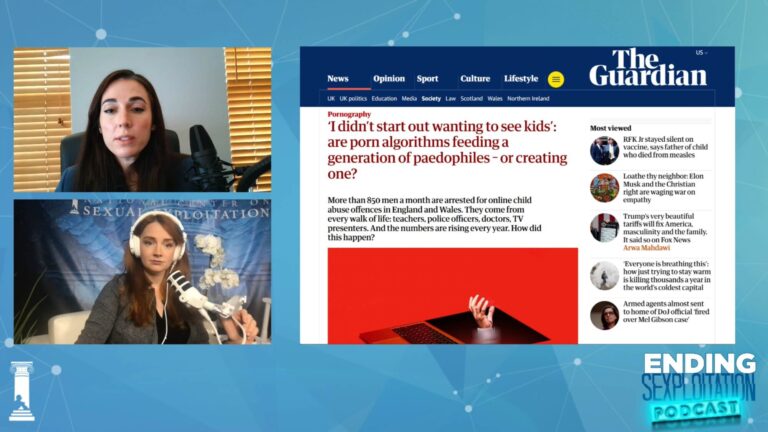*Angelina’s story is a likely story, based on the findings of research. Angelina is not a real individual.
When Angelina* first watched the Disney movie Frozen, she promptly became obsessed. For the next several months, little Angelina could constantly be found toddling about the house, singing “Let it gooooo” at the top of her lungs.
Brave and beautiful Elsa became Angelina’s idol. On Halloween, Angelina donned an Elsa costume. When she turned 6-years-old, she had an Elsa-themed birthday party. At school, she invariably spent her recesses playing “Elsa and Anna” with her best friend Carlie. (Angelina was always Elsa. Carlie was Anna.)
One day, Angelina was on her mother’s iPad. She was allowed to use the device to entertain herself while her parents were busy cooking dinner or working.
With her tiny thumbs, Angelina typed “Elsa” into the search bar.
For the next several minutes, she swiped happily through the videos and songs and images of her well-beloved Frost Queen.
Then, Angelina arrived at a video titled “Frozen Elsa and Anna Hardcore BDSM.”
She clicked on it…

We need go no further into what Angelina would have seen that day. The above image depicts the first page of results when NCOSE researchers typed the words “Elsa Frozen” into Pornhub. For your protection, we blocked all thumbnails and blurred explicit language. But girls like Angelina would not have enjoyed such protection.
The disturbing reality is that cartoon pornography, often depicting characters from mainstream children’s shows, is more prevalent than you might think. And new research suggests this subset of pornography is apt at drawing in young children like Angelina.
The Prevalence of Cartoon Pornography Exposure among Young Children
Cartoon Pornography is not an issue which is on many parents’ radar—even those parents who are aware of the threat of “regular” pornography (i.e., photographic pornography). However, recent research from the British Board of Film Classification demonstrates that the risk of children being exposed to cartoon pornography is not at all negligible.
This BBFC study analyzed the top 100 pornography sites visited by children aged 6-12 in the UK. Eight of these sites were cam sites and consequently excluded from the study. Of the remaining 22 sites, 50% specialized in animated or drawn pornography—referred to in the report as “non-photographic pornography.”
A recent study found that a significant percentage of the pornography viewed by young children is "cartoon" pornography. 50% of the top 100 non-cam pornography sites visited by children aged 6-12 specialized in animated/drawn pornography. Share on XChildren aged 6-12 disproportionately visited sites specializing in non-photographic pornography, compared to groups that included older participants. For children aged 6-17, 21% of the top 30 pornography sites (excluding 6 cam sites) specialized in non-photographic pornography, and none of the top 30 sites specialized in non-photographic pornography when the sample included adults.
One possible explanation for these statistics is that cartoon pornography exposure could be serving as a “gateway” to photographic pornography consumption, with many young children starting out watching non-photographic pornography and later transitioning to photographic pornography.
It is important to note that, while the above statistics only take into account sites that specialize in cartoon pornography, this content is also very commonly consumed even on pornography sites that do not specialize in it. For example, in 2022, Pornhub’s #1 most searched term worldwide was “hentai”. Hentai is cartoon pornography that has a Japanese art style, like the art style of anime and manga.
Cartoon Pornography Preys on Children by Featuring Characters from Popular Children’s Shows
A particularly disturbing subset of cartoon pornography is content which features characters from popular children’s shows—such as the “Elsa” pornography shown in the opening anecdote. Featuring mainstream cartoon characters is likely to increase the chance that the pornography will catch the eye of young children, and that children will be accidentally exposed while conducting innocuous Google searches related to their favourite movies and tv shows.
The BBFC research found that 48.2% of the top 100 sites visited across all ages (excluding 17 cam sites) carried content featuring characters that were likely to be familiar/appealing to children. For example, the researchers found numerous pornography titles related to characters from Frozen, Tangled, Scooby Doo, The Incredibles, Pokémon, and more.
When NCOSE researchers searched for similar titles on Pornhub, we found much of the same, plus numerous titles related to classic Disney films, such as The Little Mermaid, Beauty and the Beast, Aladdin, Peter Pan, etc.
Mainstream pornography sites carry content featuring characters from popular children's shows—e.g. Anna and Elsa from Frozen. This seems specifically designed to prey on children and draw them into the destructive habit of pornography use. Share on XAnd this content is far from child friendly. Of course, no pornography is or should be intended for children. But even further than that, the BBFC noted finding content that was particularly harmful in terms of “promoting an interest in abusive relationships.” The study highlighted numerous video titles featuring themes of rape, incest, physical aggression, and more. Such titles were found despite the fact that researchers specifically avoided using search terms such as “rape” to seek out abusive content, because doing so could expose the researcher to material that constituted a possession offence under UK Law.
The abusive themes found in this study mirrors research on photographic pornography. For example, a 2021 study found that one in eight video titles presented to first-time viewers of three mainstream pornography websites described sexual violence involving incest, physical aggression and sexual assault, and non-consent.
It is nothing short of a crisis that our children are being exposed to this content that normalizes violence and abuse.
Cartoon Child Sexual Abuse Material
To make matters worse, a significant amount of cartoon pornography is actually cartoon child sexual abuse material (CSAM, the more apt term for “child pornography”).
Once again, the researchers behind the BBFC study specifically refrained from seeking out this content, as it is an offence to possess such material under UK law. However, even while avoiding searching for it, the study found that 65.1% of the non-cam sites in the top 100 pornography sites visited across all ages carried, among their most prominent content, non-photographic content that the title and/or thumbnail suggested may feature child or child-like characters. This percentage is likely a gross underestimate of the actual percentage of sites carrying this content.
The BBFC researchers also interviewed a panel of experts about their assessment of the harms of this type of material. The majority of the expert panelists expressed concern that people who view non-photographic child sexual abuse material may escalate to viewing photographic child sexual abuse material, or even eventually commit contact sex offences against children. The experts argued that this may happen due to “the normalisation of attitudes to the material and its sexual arousal potential.” In other words, even though non-photographic CSAM is not victimizing a real child, it is training the viewer to see children as a subject of sexual interest, and is desensitizing them to the crimes of contact child sexual abuse and/or consumption of photographic CSAM.
Analysis of the Risks/Harms
As part of their research, the BBFC conducted a literature review, as well as several interviews with experts, to assess the potential harms related to non-photographic pornography. Their analysis suggested the following risks, among others:
- the first sexual images seen by children can include abusive imagery contained within hentai (Japanese-style cartoon pornography)
- non-photographic pornography can be used in the sexual grooming of children
- attitudes supportive of violence toward others, such as coercive and degrading acts toward women depicted in certain types of non-photographic pornography, can lead to the objectification and abuse of women
- children want to try out things seen in pornography and other sexually explicit material and sexually abusive material
Other research on pornography in general has uncovered a myriad of harms to children, including increased risk of being sexually exploited, increased risk of committing sexual violence, increased mental health problems, poor academic achievement, and more.
For more information about the research on how pornography harms children, download our FREE resource The Most Dangerous Playground Is Now…In Our Kid’s Pockets



